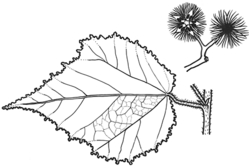Synonyms: Rulingia APNI*

Description: Trees or shrubs, prostrate to erect, stellate-tomentose. Stems, leaves and inflorescences with stellate hairs, and occasionally with intermixed clavate, glandular trichomes.
Leaves simple, ovate to broad-ovate, often cordate at base, glabrous to pubescent above, densely tomentose below, margins mostly irregularly toothed to ± entire, juvenile leaves initially trilobed, up to 6 times larger and with larger hairs than on mature leaves; petiolate; stipules early to late caducous,
Flowers bisexual, small, in cymose panicles, leaf-opposed or axillary. Calyx petaloid, 5-lobed. Petals 5, c. shorter than the calyx, with a broad base, incurved around stamens. Stamens 5, shortly united basally, opposite petals, filaments united in a short cup; staminodes 5, alternating with stamens, entire or deeply 3-lobed, central lobe wider than the 2 filiform lateral lobes. Ovary sessile, 5-locular, each loculus with 2–6 ovules; styles 5, glabrous, free (often twisted together) except at the fused, capitate stigmas.
Capsule opening into 5 valves, either glabrous or with a dense tomentum of stellate hairs, beneath reddish-brown setae (bristles), setae shaft glabrous to densely stellate hairy.
Distribution and occurrence: World: c. 58 species (Commersonia s. lat.), mainly tropical regions, South-East Asia, Australia & Pacific islands. Australia: 43 species (21 species in Commersonia s. str.; 22 species in Androcalva), all mainland States and the Northern Territory. Occurs mainly inland in heathlands, shrublands, woodlands and rainforest, on various rocky substrates.
Recent molecular studies of the Malvaceae by CF Wilkins, BA Whitlock and other authors have concluded that the Rulingia is a synonym of Commersonia. Within Commersonia s. lat., two strongly supported clades (groups) were resolved; one group representing Commersonia s. str. (including Rulingia), the other described as the new genus Androcalva. In the treatment present here, a broad generic concept is applied such that all species are treated as species of Commersonia. However, each of the key leads that identify species that Wilkins et al. include in Androcalva are annotated. For further reading links are provided to the following three papers: Polyphyly of Rulingia and Commersonia (Lasopetaleae, Malvaceae s.l.); A revision of Commersonia including Rulingia (Malvaceae s.l. or Byttneriacceae); A new Australian genus Androcalva separated from Commersonia (Malvaceae s.l. or Byttneriaceae).
Text by B.J. Conn (2013)
Taxon concept: Based in part on papers by CF Wilkins, BA Whitlock and others (2011), plus GP Guymer (Austrobaileya, volume 7)
| | Key to the species | |
| 1 | Subshrubs, prostrate or low and spreading, less than 30 cm high | 2 |
| Shrubs, erect and mostly more than 50 cm high | 5 |
| 2 | Leaves less than 25 mm long, petiole 0–3 mm long, lamina usually less than 20 mm long; spreading plants to 30 cm high | Rulingia hermanniifolia |
| Leaves more than 25 mm long, petiole more than 5 mm long, lamina usually more than 20 mm long; prostrate plants with trailing branches, less than 10 cm high
Back to 1 | 3 |
| 3 | Leaves strongly wrinkled above, margins recurved, finely crenate, mostly 3-lobed | Rulingia hermanniifolia |
| 3 | Leaves smooth to slightly wrinkled above, margins not recurved, irregularly crenate, rarely distinctly 3-lobed | 4 |
| 4 | Cymes many-flowered, longer than the petioles; capsules densely covered with bristles c. 2 mm long; petioles usually 10–20 mm long; staminodes tomentose | Rulingia prostrata |
| Cymes few-flowered, shorter than the petioles; capsules stellate-tomentose and covered with bristles c. 1 mm long; petioles mostly 6–10 mm long; staminodes glabrous
Back to 3 | Rulingia procumbens |
| 5 | Leaves more or less entire, rarely finely toothed or deeply 3-lobed; not wrinkled above | Rulingia salviifolia |
| Leaves coarsely toothed, sometimes lobed; wrinkled above
Back to 1 | 6 |
| 6 | Capsules 5–7 mm diam., bristles rigid, 2–3 mm long, with few simple or weakly stellate hairs, becoming glabrous except for apical tuft | Rulingia dasyphylla |
| Capsules mostly 8–15 mm diam., bristles softly pubescent, 2–5 mm long, hairs stellate
Back to 5 | Rulingia rugosa |
|


